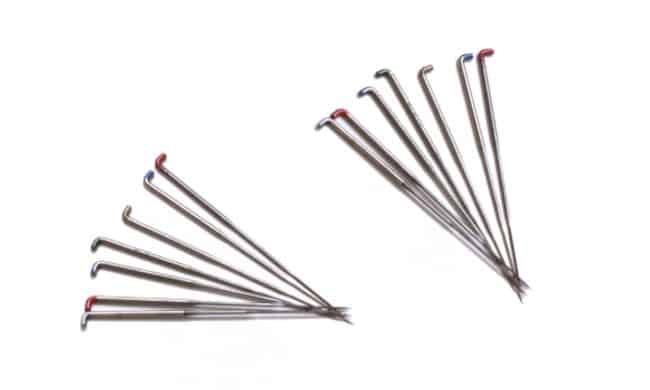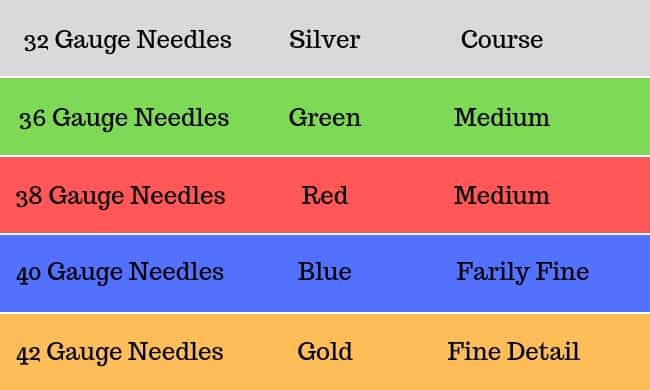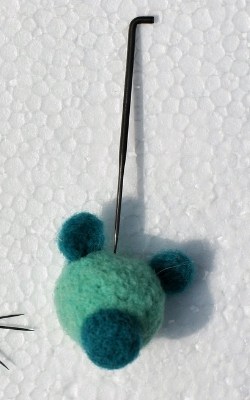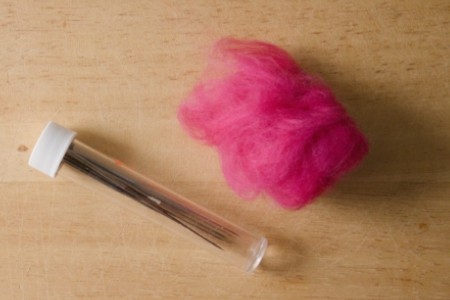
When you are learning to felt it is vital for you to learn all about your needle felting needles. You need to know all the different types of needles, the different sizes, how to use the needles what needles to use and how the needle felting needles work. This means when you go to do your needle felted project you are confident with your tools.
Needle felting needles come in lots of different shapes and sizes with different numbers of barbs for different jobs. Use them to compact your wall down into different shapes to make exciting creations of animals or people or trees or plants etc. They are very sharp and should be used with extreme care. Below I cover the different types of needles. The number two sizes, different needle colors, what each one is used for, why they break and how to avoid breaking them too often.
Felting is a fun hobby that’s reasonably easy to pick up for most people but it does need like anything some knowledge of the tools and how to use them. Needles and vital part of felting and below I cover the needles in detail.
Needle Felting Needles
- Felting needles come in different sizes and types for different tasks. As with most things felting, there is little consistency with this as everyone has their own preferences and there are lots of variations depending on the country, manufacturer, etc.
- The measurement used is different from country to country and vary from supplier to supplier. Some are S, M, L, others measure by the length of the needle as they vary depending on the size. Some are color-coded and some size eg 36,40,42.
- When I started I thought 36 smaller and 42 bigger only to find it was the other way around! The larger the number the smaller the needle.
- In addition, there are lots of different gauges. And the best size needle to use depends on the wool type as well.
So What Is A Newbie Felter Supposed To Do?
Don’t panic there are few things you can do.
To begin with, the size needle you choose will depend on what you are making and what your tutor recommends for a project.
As you progress you will naturally decide by the type of project, your preferences and the feel of the wool and how it behaves.
For instance, I read that the star needle was for punching holes. I just used it for teddy bear eyes. I didn’t know any different until one day I discovered someone said it is great for felting down a piece of work.
Your First Needle Felting Needles
If you get a kit it will give you a good selection of the most popular needles. If you want to buy them separately then I’d recommend getting a few of each of the following:
32, 36, 38, 40, 42 triangular needles.
Again, your book or project guide should give you a list of the best needles to use.
What Does a Felting Needle Look Like? Needle Types
Triangle or Crown Needle
The triangle is the most popular and widely used needle shape. This needle is as named, a triangle. On each of the three sides, the corners have small barbs.
The number of barbs will vary.
I have also heard these triangular needles referred to as crown needles.
The Star Needle
There is also a 4 sided star shape for needle again with barbs on each other corners.
The Twisted Needle
Twisted needle felting needles or twisted around in a spiral. The barbs going around in a spiral as well. This makes felting with them very very quick.
A Reverse Needle
With reverse needles in needle felting your barbs, instead of pointing downwards to push the wool into your project.
When you put the needle into the project nothing will happen. When you take your needle out it will pull the wool back out.
Forked Needles
Forked needles are split into forked shapes and have no barbs. These are used to push hair into your felted items head or body.
Why I Love Colour Coded Needles
These are just lovely. Color-coded needles have painted color on the tops of the needle. This makes a really simple and clear way to know what size felting needle you are using.
These are great for beginners and advanced filters alike. It saves hours of peering at the needle going “I think that’s a 38, no it’s not. Is it small or large, I can’t see it”, lol. It sounds funny but can be really frustrating when you need to know.
Silver Green Red, Blue & Gold
32, 36, 38, 40, 42
The colors used to mark your needle gauge vary from seller to seller. So make sure to check they are the same or you keep them separately.
Needle Felting Needle Gauge Chart for Triangular Needles

Please note this chart is based on HeidiFeathers needle colors and sizes as I often use these others may be different colors however the gauges are the same although some do it in other measurements.
Some kits come color-coded but the don’t say what the colors mean. If you keep your gauges to two or three to start with it is less confusing.
A quick way to tell is if the kit comes with instructions. Thre is a good chance that the first color needle they tell you to use will be the larger one.
Warning about color-coded needles: Some color-coded needles have a thick paint covering so will not fit into the handles. It is worth checking if you want to use a handle while you felt.
What Are Needle Felting Needles Made Of?
Some needle felting needles are made of iron and some are made of steel. The iron needles are cheaper to buy than the steel needles but they’re not as good a quality. where I live it is an extremely damp environment and I have found that the iron needles do have a tendency to rust.
However, iron needles are also extremely durable and less prone to breakage which makes them great for beginners.
How Do Felting Needles Work?

The needle felting needles that we use today in our hobby felting were originally designed to work in the large industrial felting machines. In fact, some say that’s where the hobby originated. It is said that someone saw these needles in action and decided to try them on an individual basis. They asked to borrow some and individual needle felting took off from there.
Felting needles are designed especially to compact wool and make it into felt. The large machines do this by having multiple needles pressing down in one go. This is an extremely quick process.
When individuals felt with a single or a few needles for 3D work the process is slightly different.
- When you felt as an individual rather than having hundreds of needles compact an item flat what you do is you move the needle around the object if you are doing 3D felting.
- You stab your needle into the wool lots of times in many different directions.
- The needles pick up the wool as they enter your shape and push the fiber down.
- You do this until it is a compact shape that you want. This rather than compacting straight down means that your fibers are compacted in many different directions. If you prefer you can make 2D pictures as well using the same process on a flat base.
- Each needle comes in different thicknesses and they are all extremely sharp with a very long point.
- On the sharp end of the needle, there are multiple barbs. These barbs go around your needle. These barbs point the direction to push the wool into itself. (You can get ones with barbs that face up to pull the wool back out again.
- The number of barbs varies depending on the needle and compassion needed.
- Needles also come in different shapes.
- Most people use the triangular needle for the majority of work. However, there are other shapes like the star, etc depending on what you want to use it for.
- You can use one needle or multiple needles for your projects.
Using one needle and some wool you can make lots of interesting and unique items with everything from mice, to sloths, to bears or even people by simply compacting different wool down into felted shapes.
You can also buy your own needle felting machines to speed up the process.
What Felting Needles To Use
What felting needles you use really depends on what project you’re doing on your own personal preferences. If you’re doing a really large project you may decide to use on multiple needle tool in which case you will use fine needles although you use more of them. If you’re doing a smaller project or an individual needle tool you will start off using larger needles and work to the finer for the more detailed work. Some people prefer to mix and match their needles to avoid creating holes.
Most projects tend to use the triangular needles of different sizes. Some people prefer to use star needles. And if you are pulling the wool out you will need to use the reverse needle.
If you are learning and you get the kit you have a rocky of needles in there or recommend that you use the ones that are advised. As I say the triangular is the best option to start with.
Not only do needles come in different sizes they cuddle different quantities of barbs so you will want to start a project using needles with more barbs in order to compact your work faster.
Why Do Felting Needles Break?
- Felting needles are really fragile.
- They also break more with age and use.
- Poor felting methods. Some people don’t break many while others get through lots. My sister has refused to share her needles with my niece as she totals them! If this is you don’t worry about it. Time, practice and learning methods should reduce needle breakage.
- Hitting armatures. If you use wire inside your project it is very easy to hit it with the needle resulting in more needle damage and breakage.
Tip: While you want quality needles when you are starting out you are more likely to break the needles so you might want to buy reasonable quality but not too expensive.
How To Avoid (Or Reduce) Needle Breakage When You Felt
Swap your needles while you work
- The best way to avoid needle breakage is to keep them straight.
It is all too easy when you are felting to turn the project or twist the needle when you are working. This increases your chances to break your needle. Do not move your project until the needle has been removed from it. - Also hitting things with it can result in breakage too. If you are using armatures you need to felt at an angle that avoids hitting them as much as possible.
- Swap your needles while you work to keep them fresh. Needles get “hot” with use. Swapping them for fresh ones helps keep them “cool”.
- Also, as with anything needles will age and become blunt over time. These will need replacing. This is because as they become blunt are they are less effective and more likely to break.
How to Store Your Needle Felting Needles Safely

It’s worth keeping your needles in their plastic tube if you have one as it protects the needle as they are very fragile and protects you from getting stabbed. It’s quite damp where I live and one needle I had left out went all rusty. This may depend on needle material though.
Depending on the material some needles if not being used need oil to protect them.
While you are felting make sure you keep your needles safe and stuck into something for your protection and theirs.
